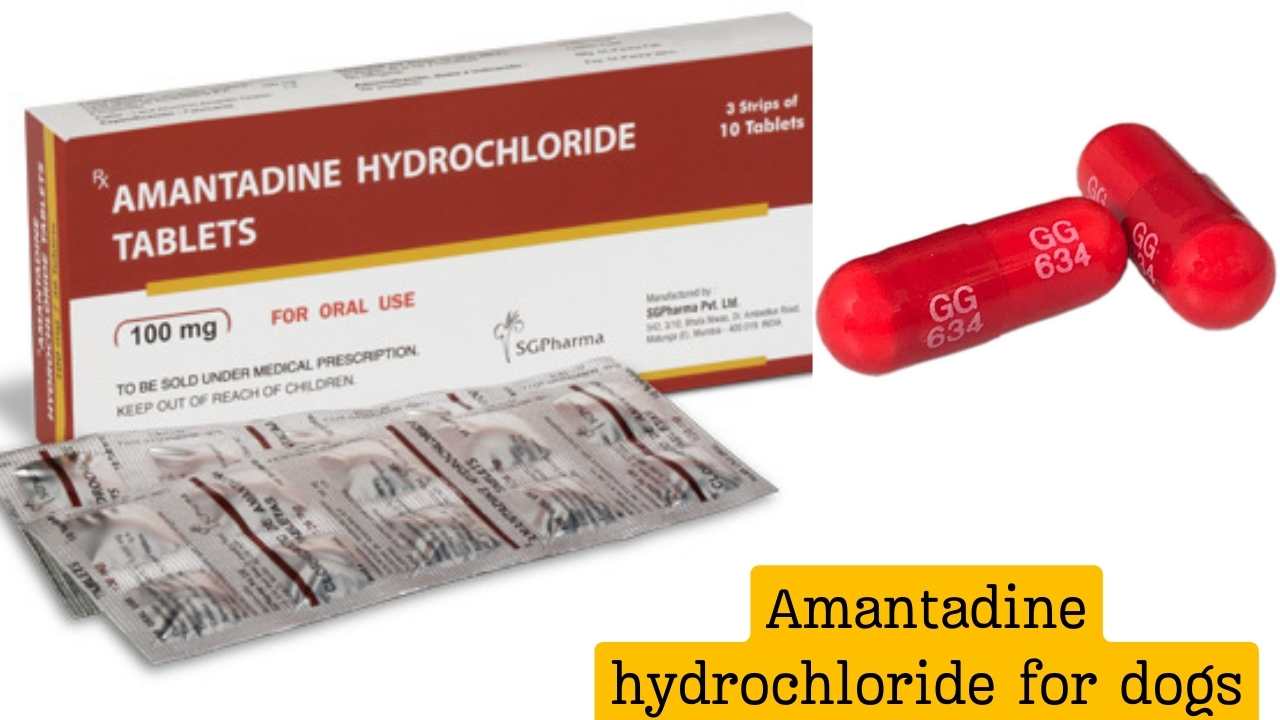Amantadine hydrochloride for dogs is commonly used in veterinary medicine to help manage pain and treat neurological disorders in dogs. Understanding how this medication works, its common uses, administration, dosage, potential side effects, and consulting a veterinarian before use is essential for pet owners looking to improve their furry friend’s quality of life.
Always consult your veterinarian before starting any new medication on your dog to ensure its safety and well-being. By understanding the benefits and risks of Amantadine hydrochloride for dogs, you can make informed decisions to improve your furry friend’s quality of life.
Amantadine hydrochloride for dogs Amantadine Hydrochloride
This is a medication initially developed to treat influenza in humans. Over time, its effectiveness in managing pain and neurological conditions in dogs has led to its widespread use in veterinary medicine.
Amantadine Work in Dogs
Amantadine blocks specific receptors in the brain, thereby reducing pain signals and improving the dog’s overall comfort levels. It can also increase dopamine levels, a neurotransmitter involved in neurological functions.
Amantadine Used in Veterinary Medicine
Veterinarians often prescribe Amantadine for dogs suffering from chronic pain conditions, such as osteoarthritis, cancer-related pain, or other neurological issues like canine cognitive dysfunction syndrome. Its effectiveness in managing these conditions makes it a valuable tool in veterinary care.
Benefits
Amantadine hydrochloride can significantly benefit dogs by managing pain and improving mobility; however, it is essential to be aware of the potential risks involved, such as gastrointestinal upset and seizures.
Common Uses of Amantadine for Dogs
- A. Pain Management in Canine Patients Amantadine is used to manage chronic pain in dogs. Whether the pain is from arthritis, cancer, or other conditions, this medication can help improve the dog’s quality of life by reducing discomfort and inflammation.
- B. Treatment of Canine Neurological Disorders: Dogs with neurological disorders like epilepsy or cognitive dysfunction may benefit from Amantadine’s ability to modulate brain activity and improve symptoms associated with these conditions.
- C. Use in Canine Rehabilitation and Physical Therapy: In cases where dogs require physical therapy or rehabilitation, Amantadine can aid in reducing pain and enhancing mobility, allowing them to recover faster and more comfortably.
Administration and Dosage of Amantadine
- A. Recommended Dosage Guidelines for Dogs: The dosage of Amantadine for dogs varies depending on the treated condition and the dog’s size and weight. It is crucial to follow your veterinarian’s instructions carefully to ensure the correct dosage is administered.
- B. Important Considerations for Administering Amantadine: Administering Amantadine with food may help reduce stomach upset in dogs. It’s essential to give the medication exactly as directed and not to skip doses to maintain its effectiveness.
- C. Potential Side Effects and Risks of Overdosing: While generally safe, Amantadine can cause side effects like vomiting, diarrhea, or restlessness in some dogs. In rare cases, overdosing can lead to more severe symptoms, so it’s crucial to monitor your dog closely when starting this medication.
-

Amantadine hydrochloride for dogs
Clinical Studies and Research on Amantadine for Dogs
A. Efficacy of Amantadine in Canine Pain Management
Research has shown that Amantadine effectively manages pain in dogs, with many experiencing improved comfort and mobility when prescribed medication.
B. Long-Term Effects of Amantadine Use in Dogs
Long-term use of Amantadine in dogs has been studied, showing that it can be a safe and beneficial option for managing chronic conditions while maintaining the dog’s overall well-being.
C. Comparison of Amantadine with Other Pain Medications for Dogs
Compared to other pain medications, Amantadine offers a unique mechanism of action that can complement traditional treatments or be used as a standalone option for pain management in dogs.
Consultation with a Veterinarian Before Using Amantadine for Dogs
- A. Importance of Seeking Professional Advice: Before starting your dog on Amantadine, it’s crucial to consult with your veterinarian to ensure this medication is the right choice for your furry friend and to discuss any potential concerns or questions you may have.
- B. Discussing Potential Drug Interactions and Allergies: Your veterinarian can also help identify potential drug interactions or allergies that may affect your dog when taking Amantadine, ensuring its safety and well-being.
- C. Checking and Changing Treatment Plans on a Case: Regular check-ins with your veterinarian can help monitor your dog’s response to Amantadine and make any necessary adjustments to its treatment plan to ensure continued effectiveness.
- Amantadine hydrochloride for dogs: Amantadine hydrochloride is commonly used to treat chronic pain related to osteoarthritis and other degenerative joint diseases in dogs. It can also be prescribed to manage neuropathic pain, such as that caused by intervertebral disc disease. Additionally, veterinarians may recommend amantadine hydrochloride for dogs with cancer to help alleviate pain and improve quality of life.
Amantadine hydrochloride for dogs dosage
- The dosage of amantadine hydrochloride for dogs varies depending on the condition being treated and the dog’s weight.
- It is often given once or twice daily, with or without food.
- Always follow your veterinarian’s dosage and administration instructions to obtain the best possible results for your dog.
Amantadine 100 mg for dogs dosage chart
- The dosage of amantadine hydrochloride for dogs is generally 3-5 mg/kg of body weight twice daily.
- A 100 mg tablet would equate to approximately one tablet for a 20-30 kg dog.
Amantadine hydrochloride for dogs” side effects
- Amantadine hydrochloride for dogs commonly causes moderate gastrointestinal disturbance, such as vomiting or diarrhea.
- In rare cases, more severe side effects like seizures or behavioral changes may occur.
- You must monitor your dog closely for adverse reactions and consult your veterinarian if you have any concerns.
Amantadine for dogs reviews
- Many dog owners report positive experiences using Amantadine to manage their pet’s pain.
- Owners often note improvements in mobility, activity levels, and overall quality of life in their dogs.
- However, every dog is unique, and individual responses to Amantadine may vary.
Amantadine hydrochloride for dogs dosage chart
- Refer your veterinarian for a personalized dosage chart tailored to your dog’s needs.
- The dosage may need to be adjusted over time based on your dog’s response to treatment and any changes in its condition.
How I give my dog gabapentin and Amantadine: Both
- Combining gabapentin and Amantadine is generally safe and can be beneficial for managing certain types of pain.
- However, always consult your veterinarian before giving your dog multiple medications to ensure no interactions or contraindications.
Amantadine 100 mg for dogs dosage: how long does
- The duration of dog treatment with amantadine hydrochloride can vary depending on the underlying condition and the dog’s response to the medication.
- Your veterinarian will guide you on how long your dog should take Amantadine and whether any adjustments to the dosage are necessary.

Amantadine hydrochloride for dogs
Summary
You can make confident decisions about your pet’s healthcare and save your dog’s life. Always care for your dog’s well-being and consult with professional doctors who know about this skill before starting any new medication regimen.
A. Key Points on Amantadine Hydrochloride for Dogs: Amantadine hydrochloride is a valuable tool for managing pain and neurological disorders in dogs. It provides relief and improves the quality of life for these patients.
B. Importance of Proper Use and Monitoring: Proper administration and monitoring of Amantadine use in dogs is crucial for ensuring the medication’s effectiveness and safety for your furry friend.
C. Potential Benefits and Risks of Treatment: While Amantadine offers many benefits for dogs in managing pain and neurological conditions, it’s essential to be aware of potential risks and side effects associated with its use.
Amantadine side effects
Psychomotor Agitation: Psychomotor agitation can be the most common symptom in dogs with various conditions, such as canine dysfunction or neurological disorders. Amantadine hydrochloride is used in veterinary medicine to help manage this symptom by regulating the neurotransmitters in the brain.
Depression: Dogs can experience depression due to various factors, including separation anxiety and chronic pain. Amantadine hydrochloride for dogs has shown promising results in alleviating depressive symptoms in dogs. It affects certain types of receptors in the brain.
Hallucination
It can be frightening and disorienting for both the pet and its owners. In some cases, amantadine hydrochloride for dogs has been beneficial in reducing hallucinations by modulating brain activity.
Bladder Pain: Bladder pain in dogs can be challenging to manage. Amantadine hydrochloride has been considered a treatment option to help alleviate discomfort and improve the quality of life for dogs experiencing bladder pain.
Confusion: It can influence a canine’s way of behaving and general prosperity. Amantadine hydrochloride has been studied for its potential to improve cognitive function and reduce confusion in dogs.
Constipation: Constipation in dogs can be a distressing condition that affects their gastrointestinal health. It is the mother of all diseases. Amantadine hydrochloride may be prescribed for dogs to help regulate bowel movements and relieve constipation.
Anorexia: It can indicate underlying health issues and behavioral concerns. Amantadine hydrochloride has been explored as a possible treatment for dogs. It stimulates appetite and promotes healthy eating habits.
Drowsiness: Drowsiness is the most common side effect of certain situations, including amantadine hydrochloride for dogs. It is essential to monitor your dog for signs of excessive drowsiness. It also reports any concerns to your veterinarian promptly.
Dizziness: Dogs may also experience dizziness or imbalance when taking the amantadine hydrochloride. This side effect can be closely monitored, and adjustments can be made to the medication dosage. These may be necessary to minimize these effects and are suitable for dogs.
Remember, every dog is unique and expensive, and their response to medications like amantadine hydrochloride can vary. It is essential to work with your veterinarian to determine the best course of treatment for your furry friend and relatives.

Amantadine hydrochloride for dogs
These tablets are useful for dogs and can be a valuable tool in managing pain and improving the quality of life for dogs with various health conditions. By working closely with your veterinarian and carefully monitoring your dog’s response to treatment, you can help ensure the benefits of Amantadine outweigh any potential risks.
FAQs:
Q1: How long does Amantadine take to start working with dogs?
The effects of amantadine hydrochloride on dogs typically start to show within 2-4 weeks of consistent use. For optimal results, it is important to follow the veterinarian’s instructions regarding dosage and administration.
Q2: What is the benefit of amantadine hydrochloride?
Amantadine hydrochloride for dogs is commonly used to treat chronic pain in dogs, especially in cases of osteosarcoma or arthritis. It can also improve mobility and quality of life for dogs suffering from degenerative joint diseases.
Q3: What is the action of amantadine hydrochloride?
Amantadine hydrochloride for dogs works by blocking the reuptake of certain neurotransmitters in the brain, such as dopamine and norepinephrine. This action enhances the effectiveness of pain relief and improves overall mobility in dogs.
Q4: What is the disadvantage of Amantadine?
One of the main disadvantages of Amantadine is its potential to cause gastrointestinal upset in some dogs, leading to symptoms like vomiting or diarrhea. It is crucial to monitor the dog’s response to the medication and consult the veterinarian if any adverse effects occur.
Q5: Which one is a severe side effect of taking Amantadine?
A severe side effect of taking Amantadine in dogs is seizure activity. If a dog experiences seizures while on Amantadine, immediate medical attention is required.




0 Comments